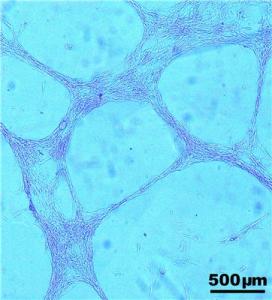A research work is being carried out to analyze the application of new reinforced hydroxyapatite ceramic materials as bone replacements.
Scientists from Carlos III University in Madrid (UC3M), the Instituto de Cerámica y Vidrio of the CSIC and the Instituto de Investigación Sanitaria of Gregorio Marañón Hospital have teamed up to work on this project.
 Cell in culture image taken with a optical microscope
Cell in culture image taken with a optical microscope
Hydroxyapatite (HA) compounds are extensively used to replace bone tissue in dental and orthopedic implants. The chemical composition of HA materials is same like bone tissue’s inorganic constituent and its mechanical properties are similar to mineral bone. Still, the use of HA-made prosthesis supports only lighter loads as it is fragile. Hence, the mechanical properties of HA material need to be altered if the implant has to handle heavier loads. A technique used to achieve this includes a composite of biocompatible oxides and HA. It is vital to design and optimize new biomaterials for establishing proper balance between their biological and mechanical properties. To identify whether the new material can be used as a biomaterial, it is essential to do a biocompatibility analysis, initially in vitro tests and later in vivo tests.
The researchers used a slip casting technique to create the material. HA material characterization will be performed at UC3M’s Nanostructured and Multifunctional Materials Laboratory. In addition, biocompatibility tests utilizing in vitro cell cultures are being carried out in the Gregorio Marañón Hospital’s Genetics Unit. Characterization of HA material is very important before the material undergoes the cell culture process. This involves measurement of the material’s porosity, density and mechanical properties such as its elastic module, micro hardness and resistance to compression. After the completion of cell culture process, the HA material will be examined using electronic and optic microscopes to verify and measure cell proliferation.